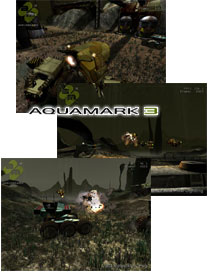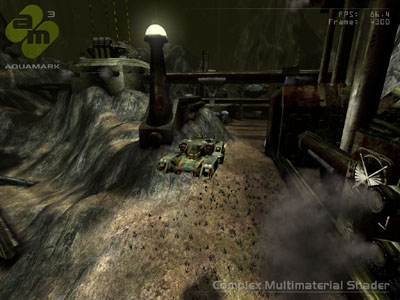Page 8 - AquaMark 3
 AquaMark 3 from Massive Development
AquaMark 3 from Massive Development
The latest graphics cards on the market are almost all DirectX9 compatible these days, and we also see an increasing number of games utilizing the new DX9 features. To be able to see how well a graphics cards is performing in this new challenging DirectX 9 environment, AquaMark was developed.
The AquaMark3 benchmark delivers scores for specific hardware components as well as an overall score for the entire system. AquaMark3 is highly qualified to meet the needs of gamers because it's as close as possible to a typical game application. The AquaMark benchmarking series is based directly on the huge code and data base of the AquaNox games and the underlying krass game engine."
In the past we have used AquaMark 2.3 in our benchmark suite and although still a reputable application, Massive figured it was time for the next best thing. This is AquaMark 3, a benchmark that will utilize some of the finest DirectX 9 capabilities like Pixel and Vertex Shaders 2.0, and yet is by far not as Shader dependant as Half-Life is, for example. You will notice that in the overall results later in this article.
AquaMark 3, however, is not solely a DirectX9 benchmark; if you are working with a DirectX 8 or 7 compatible graphics card, you will still be able to use it just with a lot of graphical features missing. Make no mistake, AquaMark3 is a DirectX 9 benchmark. But since it's based on a real game engine it has fallbacks to DirectX 8 and even DirectX 7 making this software not a 100% DX9 benchmark.
Download: Aquamark 3 (63 MB)
First let's have a look at RAW performance, no Anisotropic filtering is enabled here, and Anti Aliasing has been disabled.
| AquaMark 3 | 800x600 | 1024x768 | 1280x1024 | 1600x1200 |
| FX 5600 | 24 | 21 | 17 | 13 |
| 9600 256 | 29 | 23 | 17 | 13 |
| Creative R9600 | 29 | 23 | 17 | 13 |
| 9600 Pro | 31 | 25 | 19 | 14 |
| FX 5700 Ultra | 41 | 35 | 27 | 21 |
| 9700 Pro | 46 | 41 | 33 | 26 |
| 9800 Pro | 49 | 45 | 38 | 30 |
| 5900 | 49 | 44 | 37 | 30 |
| Blaster5 FX5900 | 49 | 44 | 37 | 30 |
| 9800 Pro | 50 | 44 | 38 | 30 |
| 9800XT | 51 | 46 | 40 | 33 |
| FX 5900 Ultra | 52 | 48 | 41 | 34 |
| FX 5950 Ultra | 53 | 49 | 43 | 36 |
As you can see the names look a bit funny. The numbers behind them represent the driver used. Without Anisotropic filtering and AA enabled here, the results are in favor for NVIDIA in the high-end range. This will change when we enable some IQ settings though. As you can see the Radeon 9600 is faster than the GeForce FX 5600 Ultra series.
| 4xAA 8xAF | 800x600 | 1024x768 | 1280x1024 | 1600x1200 |
| FX 5600 | 16 | 13 | 9 | 7 |
| Creative R9600 | 21 | 16 | 12 | 7 |
| 9600 256 | 21 | 16 | 12 | 8 |
| 9600 Pro | 24 | 18 | 13 | 9 |
| FX 5700 Ultra | 26 | 19 | 14 | 11 |
| FX 5900 | 34 | 27 | 20 | 15 |
| Blaster5 FX5900 | 34 | 27 | 20 | 15 |
| 9700 Pro | 39 | 32 | 24 | 19 |
| FX 5900 Ultra | 39 | 31 | 23 | 17 |
| FX 5950 Ultra | 40 | 32 | 24 | 18 |
| 9800 Pro | 43 | 36 | 27 | 21 |
| 9800XT | 45 | 39 | 30 | 23 |
Again you can see the Radeon 9600 is faster than the GeForce FX 5600 Ultra series. It's obvious that the mighty Radeon series have the overall performance edge here, especially the mid-range dominates. The results as demonstrated here on all cards have Anti Aliasing at 4x and Anisotropic Filtering at 8x enabled, the R9600 256Mb is having a really tough ride here though.

